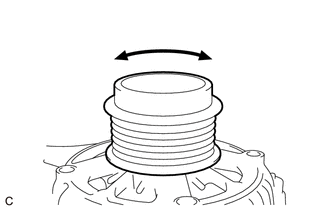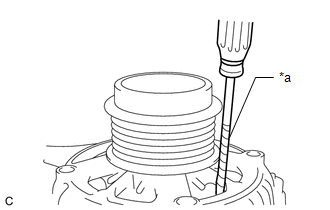Toyota Yaris: Charging System / Noise Occurs from V-ribbed Belt or Generator Assembly
PROCEDURE
| 1. | CONFIRM PROBLEM SYMPTOM |
(a) Confirm the problem symptom.
| Symptom | Proceed to |
|---|---|
| Noise occurs from V-ribbed belt | A |
| Noise occurs from generator assembly | B |
| B |
 | GO TO STEP 6 |
|
| 2. | CHECK FAN AND GENERATOR V BELT |
(a) Check the fan and generator V belt for wear or damage.
OK:
The fan and generator V belt is not worn or damaged.
| NG |
 | REPLACE FAN AND GENERATOR V BELT |
|
| 3. | CHECK GENERATOR PULLEY WITH CLUTCH FOR WEAR |
(a) Check the generator pulley with clutch grooves for wear or damage.
OK:
The generator pulley with clutch grooves are not worn or damaged.
| NG |
 | REPLACE GENERATOR PULLEY WITH CLUTCH |
|
| 4. | CHECK FOR NOISE WHILE CLUTCH PULLEY IS OPERATING |
(a) Start the engine and check the generator pulley with clutch for looseness.
OK:
The generator pulley with clutch is not loose.
| NG |
 | TIGHTEN GENERATOR PULLEY WITH CLUTCH TO SPECIFIED TORQUE |
|
| 5. | INSPECT GENERATOR PULLEY WITH CLUTCH (UNIT INSPECTION) |
(a) Remove the generator assembly.
Click here

(b) Check the installation condition of the generator pulley cap.
OK:
The generator pulley cap is not loose or missing.
(c) Check for forming of particles due to friction (for dry type pulley) or grease leaks (for wet type pulley).
OK:
There are no large amounts of particles (for dry type pulley) or grease leaks (for wet type pulley).
(d) Check the generator pulley with clutch for misalignment (interference with the generator assembly).
OK:
The generator pulley with clutch is not misaligned (no interference with the generator assembly).
| (e) Turn the generator pulley with clutch clockwise and counterclockwise by hand and check for noise. OK: Noise does not occur when turned in either direction. |
|
(f) Turn the generator pulley with clutch clockwise and counterclockwise by hand and visually check for runout.
OK:
The generator pulley with clutch does not have runout.
| (g) Hold the generator rotor assembly (fan) in the generator assembly with a screwdriver with its tip wrapped with protective tape, and check that the generator pulley with clutch locks when turned clockwise and turns freely when turned counterclockwise. OK: The generator pulley with clutch locks when turned clockwise and turns freely when turned counterclockwise. |
|
| OK |
 | INSPECT PULLEY OTHER THAN GENERATOR ASSEMBLY PULLEY |
| NG |
 | REPLACE GENERATOR PULLEY WITH CLUTCH |
| 6. | CHECK FOR NOISE WHEN ROTOR IS TURNING FREELY |
(a) Perform a road test and check that noise does not occur when decelerating.
OK:
Noise does not occur.
(b) Stop the engine and check that generator pulley with clutch noise does not occur as the engine stops.
OK:
Noise does not occur.
| NG |
 | REPLACE GENERATOR PULLEY WITH CLUTCH |
|
| 7. | CHECK ENGAGEMENT OF GENERATOR PULLEY WITH CLUTCH |
(a) Remove the generator assembly.
Click here

(b) Hold the generator rotor assembly (fan) in the generator assembly with a screwdriver with its tip wrapped with protective tape, and check that the generator pulley with clutch locks when turned from counterclockwise (free turning direction) to clockwise (locking direction).
OK:
The generator pulley with clutch locks.
| OK |
 | REPAIR OR REPLACE GENERATOR ASSEMBLY |
| NG |
 | REPLACE GENERATOR PULLEY WITH CLUTCH |
 Charging Failure
Charging Failure
PROCEDURE 1. CHECK GENERATOR PULLEY WITH CLUTCH (ON-VEHICLE INSPECTION) (a) Start the engine and visually check that the generator rotor assembly (fan) in the generator assembly is operating...
 Generator
Generator
..
Other information:
Toyota Yaris XP210 (2020-2026) Reapir and Service Manual: Left Front Wheel Speed Sensor Supply Voltage Circuit Short to Ground or Open (C14E014,C14E314)
DESCRIPTION Refer to DTC C05001F. Click here DTC No. Detection Item DTC Detection Condition Trouble Area DTC Output from C14E014 Left Front Wheel Speed Sensor Supply Voltage Circuit Short to Ground or Open With the +BS terminal voltage 9...
Toyota Yaris XP210 (2020-2026) Owner's Manual: Fuel-Filler Cap
OpenTo remove the fuel-filler cap, turn it counterclockwise. Attach the removed cap to the inner side of the fuel lid. CloseTo close the fuel-filler cap, turn it clockwise until a click is heard. NOTICE If the check fuel cap warning light illuminates, the fuel-filler cap may not be properly installed...
Categories
- Manuals Home
- Toyota Yaris Owners Manual
- Toyota Yaris Service Manual
- To Set Speed
- Engine Start Function When Key Battery is Dead
- Immobilizer System
- New on site
- Most important about car
Break-In Period
No special break-in is necessary, but a few precautions in the first 600 miles (1,000 km) may add to the performance, economy, and life of the vehicle.
Do not race the engine. Do not maintain one constant speed, either slow or fast, for a long period of time. Do not drive constantly at full-throttle or high engine rpm for extended periods of time. Avoid unnecessary hard stops. Avoid full-throttle starts.






